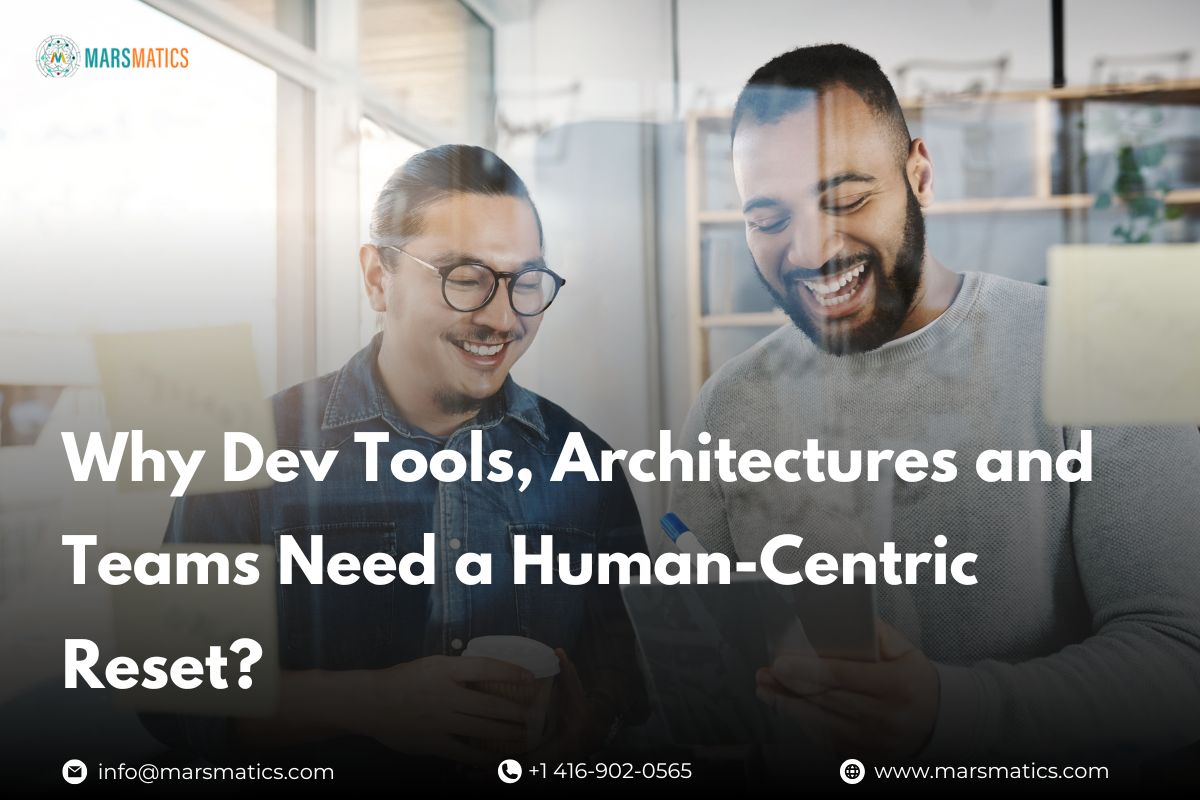Why Dev Tools, Architectures and Teams Need a Human-Centric Reset?
Technology is growing faster than the humans behind it. While automation and AI have made coding, testing, and deployment faster than ever, they’ve also increased complexity, burnout, and communication gaps. That’s why the next big shift isn’t just about speed — it’s about human-centric software development. In 2026, forward-thinking teams are rediscovering what really powers innovation: empathy, clarity, and connection.
Human-Centric Shift in Software Development:
Over the past few years, Developer Experience (DX) has evolved from a side concern to a competitive advantage. Great companies now compete not only on what they build but how their developers feel while building it.
Efficiency is no longer the only success metric. Developers face constant cognitive friction from endless notifications, new frameworks, and overlapping responsibilities. Reducing mental load has become as vital as optimizing code.
AI copilots are changing workflows too — helping teams write, debug, and test faster. But this new power introduces trust challenges. Human oversight, ethical reasoning, and design empathy remain irreplaceable. A human-centered design in tech teams ensures that AI tools support creativity, not replace it.
Also Read: How to find the best software development company
Developer Tools That Empower, Not Overwhelm:
From Tool Overload to Seamless Integration
Today, the average developer uses more than 20 tools daily — IDEs, issue trackers, CI/CD dashboards, communication platforms, and analytics. Each switch breaks focus and flow. Human-centric software development means building unified environments that reduce friction and make the development journey more intuitive.
The Era of AI-Assisted Simplicity:
The best dev tools of 2026 don’t just automate; they anticipate. AI-driven environments like GitHub Copilot, Cursor IDE, and automated testing assistants simplify workflows by predicting intent, refactoring code, and preventing common mistakes before they occur. This evolution aligns with human-first development culture — designing tools that help humans perform at their best rather than forcing them to adapt to complexity.
Accessibility and Inclusivity in Dev Tools:
True innovation includes everyone. Modern toolmakers are embracing human-centered design in tech teams through accessibility — color-contrast compliance, screen-reader compatibility, and voice-based coding features. Neurodiverse-friendly UX is becoming a major differentiator for dev tools.
Architectures Built for People, Not Just Performance
Composable, Understandable Systems:
Over-engineered architectures have created an invisible tax on developers: cognitive overload. The new software architecture trends 2026 focus on composability and clarity. Readable APIs, standardized interfaces, and visual architecture mapping make systems easier to understand — empowering developers to solve problems faster and collaborate better.
Cognitive Load as a Design Metric:
A truly human-centric software development approach treats mental effort as a design constraint. Frameworks are being re-evaluated not only for performance but also for developer comprehension. Design patterns that prioritize simplicity and maintainability are now key indicators of architectural maturity.
The Rise of DevExOps:
DevExOps — the fusion of DevOps and Developer Experience — is gaining traction. It’s not just about pipelines and deployment frequency anymore. It’s about DevOps and team collaboration that prioritizes flow, feedback, and fulfillment. Teams now measure how easily developers can deploy ideas, not just code.
Re-Engineering Teams for Empathy and Collaboration:
From Command-Control to Psychological Safety:
Google’s Project Aristotle revealed that psychological safety not technical skill is the top predictor of high-performing teams.
In 2026, human-first development culture means fostering environments where developers can fail safely, share ideas openly, and innovate without fear of judgment.
The Power of Cross-Functional Collaboration:
Great products emerge when design, engineering, and product teams speak a shared language. DevOps and team collaboration frameworks now focus on empathy — understanding user pain points and aligning them with business outcomes.
Hybrid Work 2.0 — Balancing Autonomy and Connection:
Remote work is no longer new, but sustainable hybrid models require balance.
Human-centered leaders schedule “connection rituals” — virtual coffee breaks, 1:1 syncs, or weekly wellbeing check-ins — ensuring remote developers stay engaged, not isolated.
Practical Ways to Create a Human-Centric Culture:
- Conduct Developer Journey Mapping to visualize pain points in tooling and communication.
- Measure flow time (time spent in deep work) instead of only velocity or sprint points.
- Encourage mentorship, pair programming, and emotional-intelligence training.
- Introduce “Dev Health” metrics into OKRs — focus on creativity, satisfaction, and learning growth.
This approach aligns deeply with human-first development culture, ensuring both people and products evolve in harmony.
Why This Reset Matters for the Future?
In 2026, software teams face an uncomfortable truth: productivity tools have outpaced human adaptability.
Re-centering around human-centric software development ensures sustainability — mentally, emotionally, and creatively.
Empathetic design creates better products and happier developers.
Companies embracing software architecture trends 2026 and human-centered design in tech teams will see lower churn, higher innovation, and stronger long-term performance. Ultimately, technology is built by people and for people — and those who remember that will lead the next era of digital transformation.
At Marsmatics, we build software that serves people — not the other way around.
Explore how our development approach blends empathy with innovation.
👉 Let’s Build Human-Centric Solutions Together →
FAQs
What does a human-centric approach mean in software development?
It’s about designing tools, architectures, and workflows that align with how humans think, learn, and collaborate — reducing cognitive strain and improving creativity.
How is Developer Experience (DX) different from User Experience (UX)?
DX focuses on internal users — the developers — ensuring the software creation process itself is intuitive, efficient, and enjoyable.
What are examples of human-centric dev tools in 2026?
AI-assisted IDEs like Cursor AI, collaboration tools such as Notion AI and Linear, and predictive CI/CD dashboards that simplify decision-making.
How can teams start applying a human-centric reset today?
Start small: simplify toolchains, hold empathy-driven retros, prioritize psychological safety, and measure flow efficiency instead of only delivery speed.








